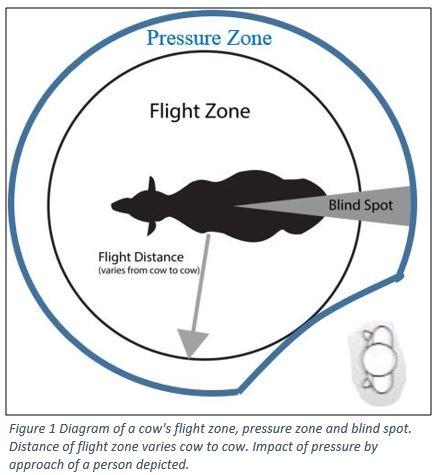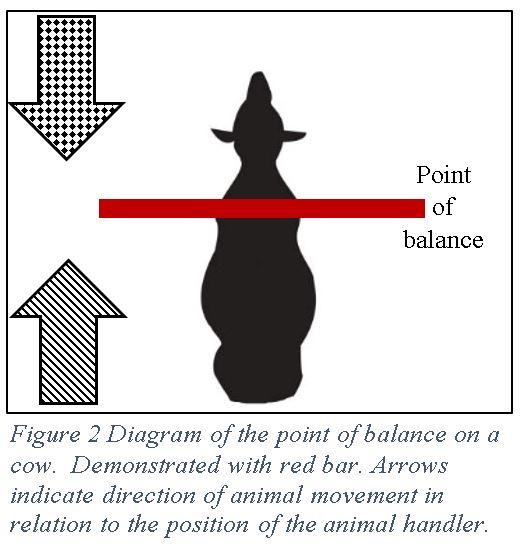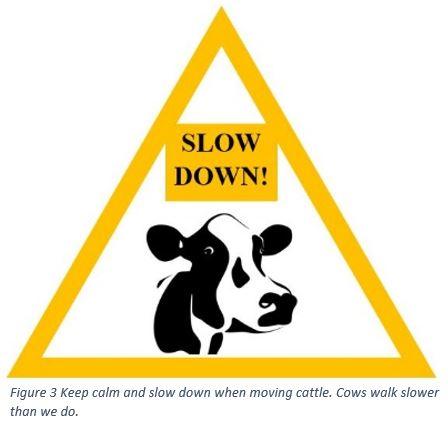Good Dairy Stockmanship: Moving Dairy Cows the Correct Way
Good Dairy Stockmanship: Moving Dairy Cows the Correct Way
Proper dairy stockmanship is crucial when moving dairy cows and proper training of farm personnel to build these skills is essential. Personnel training in dairy stockmanship skills should result in low stress handling of animals, allowing for a safe and efficient work environment for both cattle and humans. While good dairy stockmanship practices are hardly ever broadcast on the evening news, poor stockmanship is one undercover video away of making national news. This article covers some key components to remember when moving cattle.
Stockmanship Principles: The Flight and Pressure Zones

Pressure is exerted on the flight zone when a person slowly steps into the pressure zone of the cow (Figure 1), signaling the cow to move away from the person causing the pressure. Proper manipulation of a cow’s pressure zone allows a person to safely and calmly move the cow in the desired direction. Remember a cow will move in the direction her nose is pointed.Cows have a flight zone, and the size of these are different for each cow. The flight zone is the area surrounding an animal that if invaded by a predator or person, will cause alarm and escape behavior in the affected animal. Whereas, the pressure zone is the area where the cow will be attentive towards and uncomfortable with the approach of the person or predator, but the animal is not quite ready to run away. The pressure zone encompasses the flight zone of the animal (Figure 1).
Not only does the cow respond as a prey animal to stimulus on her pressure and flight zones, but also responds to other experiences in her environment. Her current environment as well as her past experiences (memories) can have an effect on a cow’s response to pressure. If a cow remembers a bad experience be it with her environment or with certain personnel, she will have a heightened stress response when faced with the same situation again. Preventing bad cow experiences is key to good stockmanship. Also, cattle will increase or decrease the radius of its pressure and flight zones in relation to the experiences with the person, situation or environment in question.
Cows Do Not Speak English or Spanish

Cows do not talk or use sign language when communicating with humans or other cows. They use their 5 senses: taste, smell, hearing, sight, and touch. As an example, cows use senses, such as taste, smell and touch, when looking for feed, showing signs of heat, or when socializing with other cows. Cows have better hearing than humans which makes them more sensitive to sounds in their environment. Cows can see 340° around them, however, just like a car they have a blind spot. They only have one blind spot which is directly behind them (Figure 1). When a person invades the pressure zone of a cow, the animal will always look at what is pressuring them. If a person was to stand directly behind a cow and apply pressure to the pressure zone, the cow will turn around to look at the person, hindering the process of moving the animals. Thus, the best position to stand when wanting to move cows forward is from the side as displayed in Figure 1. From this sideway position, make sure that you can see the eye of the cow that you want to move. Remember this basic principle: A cow cannot see you if you cannot see at least one of her eyes. When you move towards the animal and advance inside of her flight zone, if the cow can see you, she will respond calmly and move forward.
The cow’s shoulder is her point of balance (Figure 2). If a handler stands behind the point of balance, the cow will move forward. If the handler stands in front of the point of balance the cow will backup. If you want to move the cow forward, stand behind her shoulder (striped arrow, Figure 2). If you want her to backup, stand in front of her shoulder (checkered arrow, Figure 2). Remember a cow will move in the direction her nose is pointed.Cows do not talk or use sign language when communicating with humans or other cows. They use their 5 senses: taste, smell, hearing, sight, and touch. As an example, cows use senses, such as taste, smell and touch, when looking for feed, showing signs of heat, or when socializing with other cows. Cows have better hearing than humans which makes them more sensitive to sounds in their environment. Cows can see 340° around them, however, just like a car they have a blind spot. They only have one blind spot which is directly behind them (Figure 1). When a person invades the pressure zone of a cow, the animal will always look at what is pressuring them. If a person was to stand directly behind a cow and apply pressure to the pressure zone, the cow will turn around to look at the person, hindering the process of moving the animals. Thus, the best position to stand when wanting to move cows forward is from the side as displayed in Figure 1. From this sideway position, make sure that you can see the eye of the cow that you want to move. Remember this basic principle: A cow cannot see you if you cannot see at least one of her eyes. When you move towards the animal and advance inside of her flight zone, if the cow can see you, she will respond calmly and move forward.
Slow Down! Cows Walk Slower than People

Cows, when not startled or pressured, tend to walk at 2 miles per hour. The average human when working cattle walks 3 to 4 miles per hour, twice as fast as cattle. When a person walks with a group of cows at normal walking speed, the person will start to pass the animal's shoulder point of balance and it will result in cows slowing down. Once past a cow's point of balance, the cow or cows will turn around and move in the opposite, intended direction. However, if a person walks towards a group of cows moving in the opposite direction they will speed up in order to pass the person that is pressuring them.
When observing cows walking unassisted, their head is normally down so they can see where they are going to step next. A rushed cow will have her head up and not watch where she is walking because she is watching whatever is pressuring her. This could lead to slipping and tripping of the cow, possibly resulting in injury or lameness. How can this be prevented? Slow down when moving cattle and manipulate their pressure zone so the cow can see where she is going and watch the person pressuring them at the same time. When moving a group of cows, a slow zig zag pattern with a stationary rocking motion from the back of the group is most effective when trying to move cows calmly and efficiently.Cows, when not startled or pressured, tend to walk at 2 miles per hour. The average human when working cattle walks 3 to 4 miles per hour, twice as fast as cattle. When a person walks with a group of cows at normal walking speed, the person will start to pass the animal’s shoulder point of balance and it will result in cows slowing down. Once past a cow’s point of balance, the cow or cows will turn around and move in the opposite, intended direction. However, if a person walks towards a group of cows moving in the opposite direction they will speed up in order to pass the person that is pressuring them.
Stressed Cows Take Longer to Milk
Inappropriate movement of cows from their pen to the milking parlor greatly affects milk let down in the parlor. Crowd gates should only be used to apply pressure to the pressure zone, not physically push the cow toward the parlor. Sticks or hot shots should not be used to move cows toward the parlor. A cow that is stressed on the way to and in the holding pen will produce adrenaline which blocks the receptors for oxytocin, which inhibits milk let down. Cows that are stressed take longer to milk and can develop hyperkeratosis on the teat end. This roughening of the teat end provides a place for bacteria to colonize and it’s a major risk factor for mastitis. Uninhibited milk let down in the parlor can decrease the time it takes to fully milk a cow and, in turn, can increase parlor throughput. Increased parlor throughput benefits the cow and dairy personnel. The less time a cow is away from her pen, the more time she has to eat, drink, and lay down. The better the parlor throughput, the less time is spent milking with less chance of hyperkeratosis.
Take Home Messages
|
Key point to remember when moving cows
|
More Information
If you would like more information and training on proper dairy stockmanship for you or your dairy employees, numerous training videos are available online in both English and Spanish at www.dairycare365.com. You will need to register to view the videos.
Authors: Michele Jones and Donna M. Amaral-Phillips
